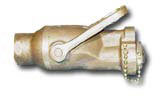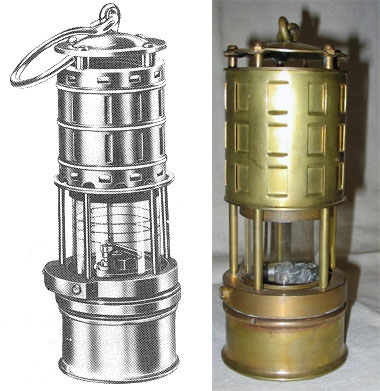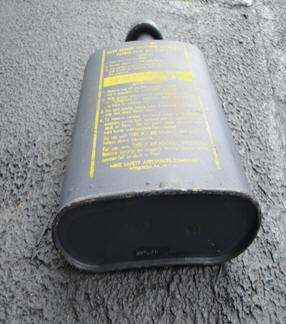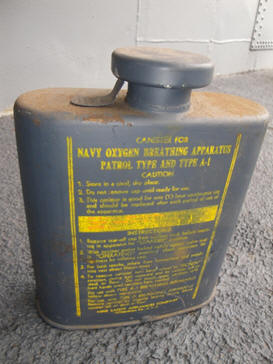|
Two types of canisters were used with the Type A-1 OBA.
One was gray and the other green. Changing Canisters on
the Type A-1 OBA There were two ways to determine if the
canister for the Type A-1 OBA needed to be changed. If
set, the timer bell would sound to indicate the canister
had been in use 30 or 45 minutes. Otherwise, if it
became an effort to exhale, and a test indicated that
the resistance was not due to over-inflation of the
breathing bag, the canister needed to be changed. To
change the canister, the wearer returned to fresh air.
With legs spread and leaning the upper part of the body
slightly forward, the hand-wheel was turned
counterclockwise to the extreme down position, the
canister stop depressed, and, with a quick forward
motion, the bail swung outward. The canister then
dropped out of the OBA. The new canister was then
inserted and the apparatus was put into use. Asbestos
mittens, leather-palmed work gloves, or an equivalent
protection for the hands were worn when changing
canisters. A used canister was very hot. The chemical
used in the OBA canister, due to the large percentage of
oxygen it contained, caused combustion of any
inflammable materials with which it was brought into
contact, especially if such materials were moist. Oil,
gasoline, or similar materials coming in contact with
the chemical in either expended or unexpended canisters
could cause an explosion. This chemical was caustic and
very injurious to the skin. The following precautions
were taken to avoid casualties: Any liquid, especially
oil and grease, was never allowed to enter the opening
of a used canister. Personnel were cautioned never to
allow unexpended or expended chemicals to spill on the
deck. If they were spilled accidentally, they were
cleaned up immediately and dumped overboard, using a
metal or non-inflammable material for a scoop. Canisters
were not to be dumped overboard if there was an oil
slick on the water. Disposal was not made until the
vessel was underway and clear of any oil slick. When
removing a canister, it was never permitted to drop it
to the deck or grating if there was loose water on the
deck or if there was the possibility that the canister
may bounce off the grating into a bilge. Carrying a used
canister in a pouch on the belt was not recommended
during firefighting operations or in compartments where
water was present on the deck, since loose water was
frequently contaminated with oil or grease. Personnel
were advised not to place their faces over the canister
opening. If the canister was opened, personnel never
handled the chemical without suitable care and
protection to the hands and body. If accidentally burned
by the chemicals, personnel reported to Sickbay
immediately, stating the cause of the burn to the
medical officer or corpsman to ensure that no petroleum
derivatives were applied to the affected area. Petroleum
jellies caused a chemical burn to become even more
severe. |






